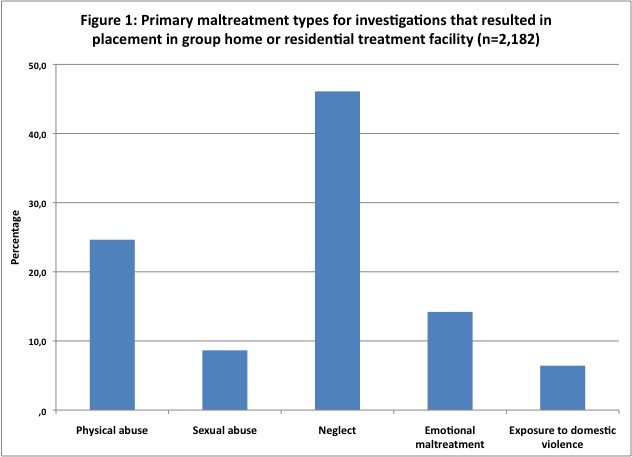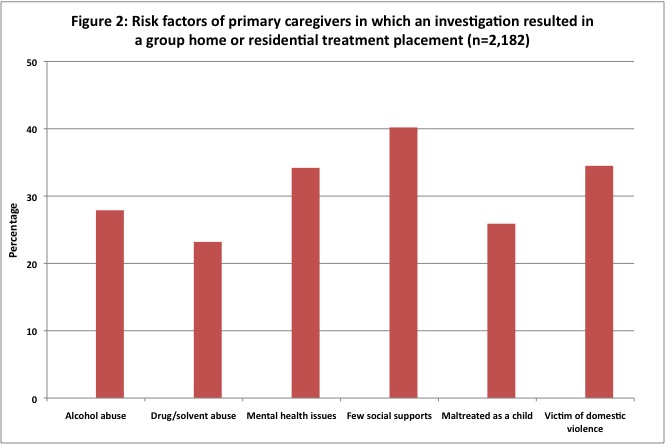CWRP Information Sheet #82E. (2010). Toronto, ON: University of Toronto, Faculty of Social Work.
Researchers and child welfare workers alike have indicated that the placement of children into group homes is a decision requiring much thought, often only proposed if kinship or traditional foster care settings would not appropriately meet the needs of the child.[fn value=1]Barth, R. P. (2002). Institutions vs. foster homes: The empirical base for the second century of debate. Chapel Hill: Annie E. Casey Foundation, University of North Carolina, School of Social Work, Jordan Institute for Families.[/fn] [fn value=2]James, S., Landsverk, J., Leslie, L. K., Slymen, D. J., & Zhang, J. (2008).Entry into restrictive care settings: Placements of last resort? Families in Society, 89, 348-359.[/fn] Findings from the 1998 cycle of the Canadian Incidence Study of Reported Child Abuse and Neglect (CIS-1998) indicate that 8% of all child maltreatment investigations in that year resulted in a child welfare placement, including foster care, group homes, and residential treatment facilities.[fn value=3]Trocmé, N., MacLaurin, B., Fallon, B., Dacuik, J., Billingsley, D., Tourigny, M., et al. (2001). Canadian Incidence Study of Reported Child Abuse and Neglect: Final report. Ottawa, ON: Minister of Public Works and Government Services Canada.[/fn]
The Canadian Incidence Study of Reported Child Abuse and Neglect (CIS-2003) [fn value=4]Trocmé, N., Fallon, B., MacLaurin, B., Dacuik, J., Felstiner, C., Black, T., et al. (2005). Canadian Incidence Study of Reported Child Abuse and Neglect–2003: Major Findings. Ottawa, ON: Minister of Public Works and Government Services Canada.[/fn] was compiled using data from 55 [fn value=5]In Quebec, information was extracted directly from the administrative information systems.[/fn] child welfare service areas across Canada, excluding Quebec. Child welfare workers in selected sampling areas completed a three-page instrument for child protection cases opened during the 2003 collection period of this study. This instrument was used to assess child and family characteristics, type and duration of maltreatment, substantiation decision, short-term service dispositions and referrals provided to the family.
The CIS-2003 defines a group home as an out-of-home structured group-living setting. A residential/secure treatment facility is defined as a therapeutic residential treatment centre. Of the estimated 2,182 child maltreatment investigations involving children aged 7-15 years that resulted in group home placements, maltreatment was substantiated in 83% of cases, suspected in 7% of cases, and not verified in 10% of cases. Previous child welfare involvement was noted for 78% of investigations in which children were placed in a group home or residential treatment facility, and 41% of children experienced maltreatment for a duration of more than six months.
What is the nature of maltreatment leading to placement in group homes and residential treatment centers?
Figure 1 illustrates the five major types of maltreatment in cases in which children were placed in group home settings.
- physical abuse: accounted for 25% of cases investigated
- sexual abuse: accounted for 9% of cases investigated
- neglect: accounted for 46% of cases investigated
- emotional maltreatment: accounted for 14% of cases investigated
- exposure to domestic violence: accounted for 6% of cases investigated

Neglect, the most prevalent form of maltreatment, is characterized by the CIS-2003 as failure to supervise resulting in harm or risk of physical harm to the child, failure to supervise resulting in an occurrence of substantial risk of sexual abuse, permitting criminal behavior, physical neglect of the child’s needs or permitting the child to be in a dangerous environment, medical neglect, failure to provide psychological treatment, abandonment, and/or educational neglect.
The second most prevalent form of maltreatment was physical abuse. In these cases, 12% involved shaking, pushing, grabbing or throwing the child.
The third most prevalent form of maltreatment was emotional maltreatment which in 11% of cases was characterized by emotional abuse.
What are the functioning characteristics of children in group homes and residential treatment programs?
A child behavioural issue was noted for 81% of investigations involving group home or residential/secure treatment placements and for 70% of investigations at least one physical, emotional or cognitive problem was noted as present for the child. Common behavioural issues were: negative peer involvement (58%), irregular school attendance (52%), at least one running attempt (46%) and violence towards others (43%). Running away attempts were noted by the CIS-2003, however, whether this behavior occurred before or after placement was unclear. Additionally, internalization problems including depression, anxiety, and self-harming behavior were identified in 30-44% of these investigations. These findings are consistent with previous research which has found children in group home and residential therapeutic facilities tend to display academic difficulties, aggressiveness, impulsivity, interpersonal problems and behaviours associated with conduct disorder.[fn value=6]Curtis, P. A., Alexander, G., & Lunghofer, L. A. (2001). A literature review comparing the outcomes of residential group care and therapeutic foster care. Child & Adolescent Social Work Journal, 18, 377-392.[/fn] It is often the presence of these issues that result in placement in restrictive child welfare settings in order for the significant needs of such children to be best served.
What are the caregiver risk factors for children placed in group homes and residential treatment programs?
In all households where an investigation of maltreatment took place, data was collected by the CIS-2003 regarding caregiver risk factors. Figure 2 presents the most common risk factors of the primary caregiver in cases that involved a group home or residential/secure treatment placement. These risk factors were: having few social supports (40%), being a victim of domestic violence (35%), mental health issues (34%), alcohol abuse (28%) and a history of maltreatment as a child (28%).

In the 2003 cycle of the CIS, 17% of unfounded or suspected cases involved placement of children in group homes or residential treatment facilities. In some of these cases, placement may be the result of voluntary care agreements between caregivers and child welfare workers. Taken together with the functioning concerns noted for children, a picture emerges that suggests these caregivers may not be well-equipped to properly manage the behavioral or emotional needs of their children.
The findings of this study contribute to a clearer understanding of the substantial behavioural issues of children placed in group and residential care settings, and the risk factors present in their caregivers. Questions still remain, however, regarding the possible efficacy of alternative placements which are less costly than such restrictive care. Due to the lack of satisfaction of many children in these settings [fn value=7]U.S. Department of Health and Human Services, Administration for Children, Youth and Families. (n.d.). National Survey of Child and Adolescent Well-Being (NSCAW), No. 2: Foster children’s caregivers and caregiving environments, Research brief, Findings from the NSCAW study. Retrieved from https://www.acf.hhs.gov/opre/resource/national-survey-of-child-and-adolescent-well-being-nscaw-no-2-foster[/fn] and the behavioural problems exhibited while in care7 less costly and restrictive alternatives within the child welfare system may be viable options for many children.
This information sheet is based on the article, DuRoss, C. R., Fallon, B., & Black, T. (2010). Group home and residential treatment placements in child welfare: Analyzing the 2003 Canadian Incidence Study of Reported Child Abuse and Neglect (CIS-2003). Canada’s Children, 16(3), 67-76.
